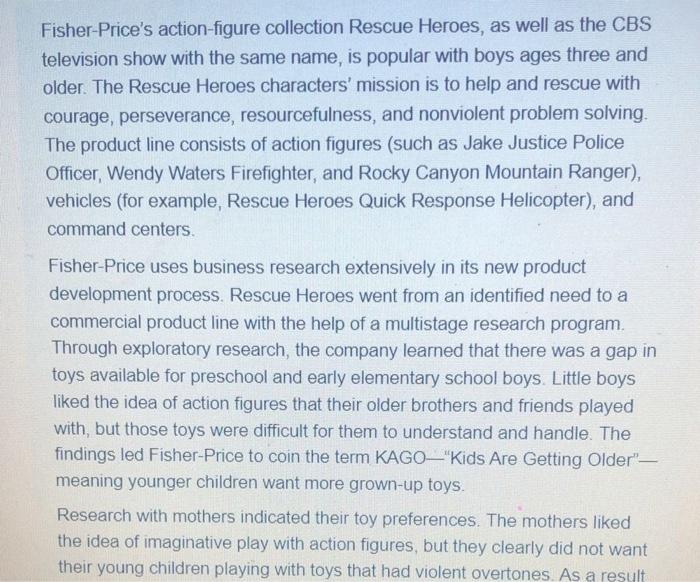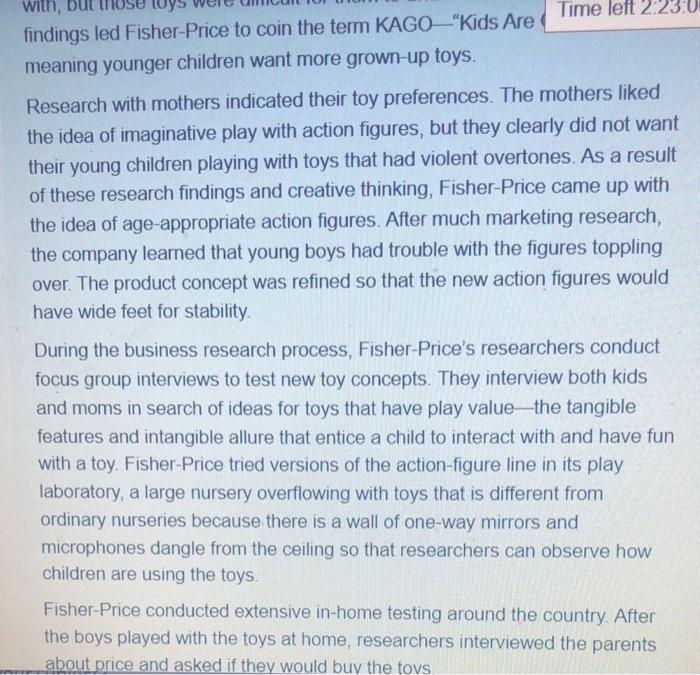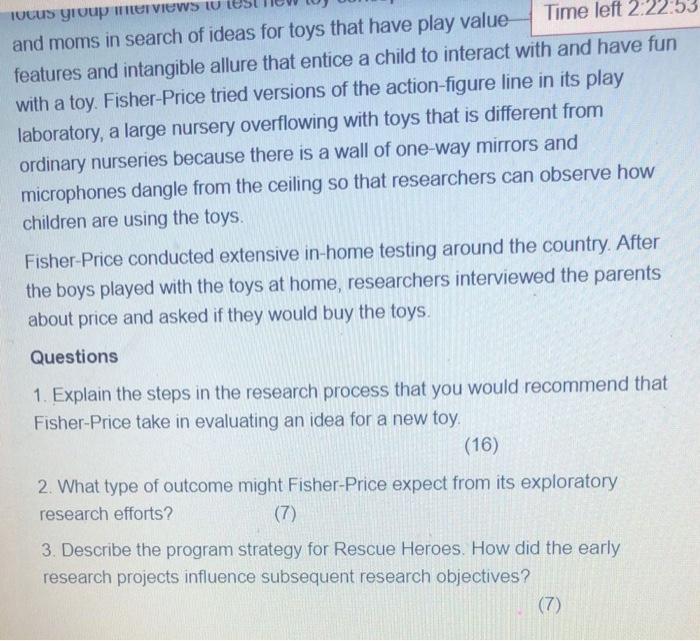Fisher-Price's action-figure collection Rescue Heroes, as well as the CBS television show with the same name, is popular with boys ages three and older. The Rescue Heroes characters' mission is to help and rescue with courage, perseverance, resourcefulness, and nonviolent problem solving. The product line consists of action figures (such as Jake Justice Police Officer, Wendy Waters Firefighter, and Rocky Canyon Mountain Ranger), vehicles (for example, Rescue Heroes Quick Response Helicopter), and command centers. Fisher-Price uses business research extensively in its new product development process. Rescue Heroes went from an identified need to a commercial product line with the help of a multistage research program Through exploratory research, the company learned that there was a gap in toys available for preschool and early elementary school boys. Little boys liked the idea of action figures that their older brothers and friends played with, but those toys were difficult for them to understand and handle. The findings led Fisher-Price to coin the term KAGO"Kids Are Getting older"- meaning younger children want more grown-up toys. Research with mothers indicated their toy preferences. The mothers liked the idea of imaginative play with action figures, but they clearly did not want their young children playing with toys that had violent overtones. As a result with, but toys Time left 2.230 findings led Fisher-Price to coin the term KAGO"Kids Are meaning younger children want more grown-up toys. Research with mothers indicated their toy preferences. The mothers liked the idea of imaginative play with action figures, but they clearly did not want their young children playing with toys that had violent overtones. As a result of these research findings and creative thinking, Fisher-Price came up with the idea of age-appropriate action figures. After much marketing research, the company learned that young boys had trouble with the figures toppling over. The product concept was refined so that the new action figures would have wide feet for stability. During the business research process, Fisher-Price's researchers conduct focus group interviews to test new toy concepts. They interview both kids and moms in search of ideas for toys that have play value the tangible features and intangible allure that entice a child to interact with and have fun with a toy. Fisher-Price tried versions of the action-figure line in its play laboratory, a large nursery overflowing with toys that is different from ordinary nurseries because there is a wall of one-way mirrors and microphones dangle from the ceiling so that researchers can observe how children are using the toys. Fisher-Price conducted extensive in-home testing around the country. After the boys played with the toys at home, researchers interviewed the parents about price and asked if they would buy the toys TUUS yrup VIEWS tule and moms in search of ideas for toys that have play value Time left 2.22:53 features and intangible allure that entice a child to interact with and have fun a with a toy. Fisher-Price tried versions of the action-figure line in its play laboratory, a large nursery overflowing with toys that is different from ordinary nurseries because there is a wall of one-way mirrors and microphones dangle from the ceiling so that researchers can observe how children are using the toys. Fisher-Price conducted extensive in-home testing around the country. After the boys played with the toys at home, researchers interviewed the parents about price and asked if they would buy the toys. Questions 1. Explain the steps in the research process that you would recommend that Fisher-Price take in evaluating an idea for a new toy (16) 2. What type of outcome might Fisher-Price expect from its exploratory research efforts? (7) 3. Describe the program strategy for Rescue Heroes. How did the early research projects influence subsequent research objectives? (7) Fisher-Price's action-figure collection Rescue Heroes, as well as the CBS television show with the same name, is popular with boys ages three and older. The Rescue Heroes characters' mission is to help and rescue with courage, perseverance, resourcefulness, and nonviolent problem solving. The product line consists of action figures (such as Jake Justice Police Officer, Wendy Waters Firefighter, and Rocky Canyon Mountain Ranger), vehicles (for example, Rescue Heroes Quick Response Helicopter), and command centers. Fisher-Price uses business research extensively in its new product development process. Rescue Heroes went from an identified need to a commercial product line with the help of a multistage research program Through exploratory research, the company learned that there was a gap in toys available for preschool and early elementary school boys. Little boys liked the idea of action figures that their older brothers and friends played with, but those toys were difficult for them to understand and handle. The findings led Fisher-Price to coin the term KAGO"Kids Are Getting older"- meaning younger children want more grown-up toys. Research with mothers indicated their toy preferences. The mothers liked the idea of imaginative play with action figures, but they clearly did not want their young children playing with toys that had violent overtones. As a result with, but toys Time left 2.230 findings led Fisher-Price to coin the term KAGO"Kids Are meaning younger children want more grown-up toys. Research with mothers indicated their toy preferences. The mothers liked the idea of imaginative play with action figures, but they clearly did not want their young children playing with toys that had violent overtones. As a result of these research findings and creative thinking, Fisher-Price came up with the idea of age-appropriate action figures. After much marketing research, the company learned that young boys had trouble with the figures toppling over. The product concept was refined so that the new action figures would have wide feet for stability. During the business research process, Fisher-Price's researchers conduct focus group interviews to test new toy concepts. They interview both kids and moms in search of ideas for toys that have play value the tangible features and intangible allure that entice a child to interact with and have fun with a toy. Fisher-Price tried versions of the action-figure line in its play laboratory, a large nursery overflowing with toys that is different from ordinary nurseries because there is a wall of one-way mirrors and microphones dangle from the ceiling so that researchers can observe how children are using the toys. Fisher-Price conducted extensive in-home testing around the country. After the boys played with the toys at home, researchers interviewed the parents about price and asked if they would buy the toys TUUS yrup VIEWS tule and moms in search of ideas for toys that have play value Time left 2.22:53 features and intangible allure that entice a child to interact with and have fun a with a toy. Fisher-Price tried versions of the action-figure line in its play laboratory, a large nursery overflowing with toys that is different from ordinary nurseries because there is a wall of one-way mirrors and microphones dangle from the ceiling so that researchers can observe how children are using the toys. Fisher-Price conducted extensive in-home testing around the country. After the boys played with the toys at home, researchers interviewed the parents about price and asked if they would buy the toys. Questions 1. Explain the steps in the research process that you would recommend that Fisher-Price take in evaluating an idea for a new toy (16) 2. What type of outcome might Fisher-Price expect from its exploratory research efforts? (7) 3. Describe the program strategy for Rescue Heroes. How did the early research projects influence subsequent research objectives? (7)









